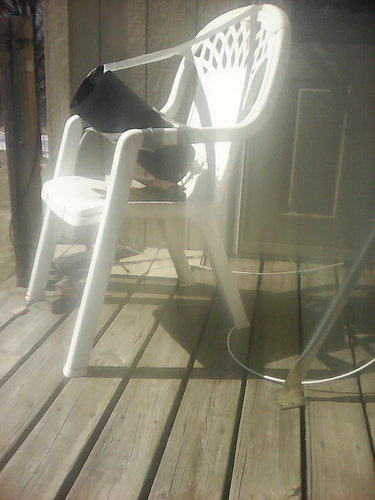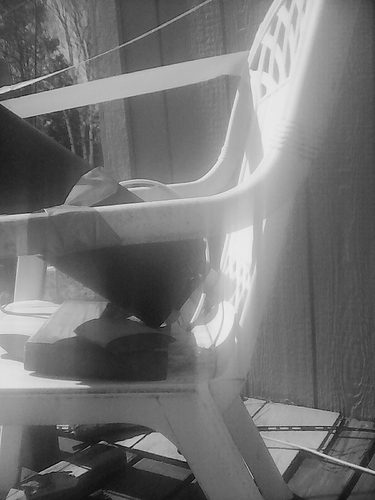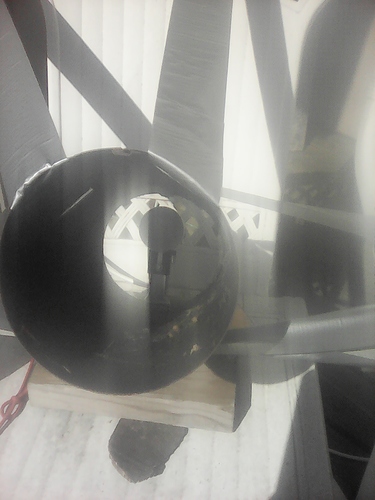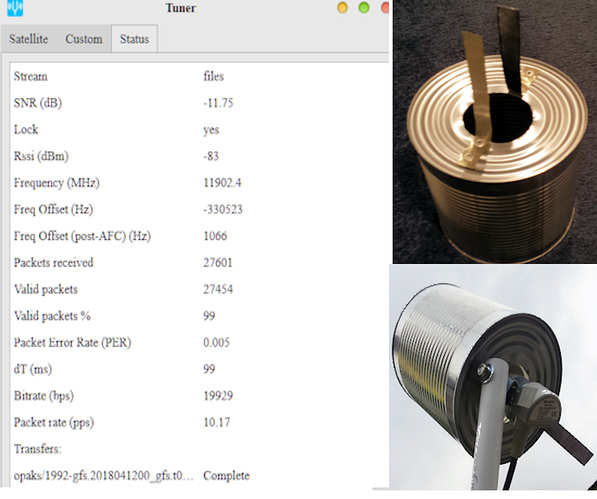Ken, if you notice where your horn is attached with relation to the actual receiving element in the LNB, we aren’t close to real specifications on real feed horns. I worked with a small 10 gHz gunn-diode device in sending video pcm a short distance for several years, and if you examine the horn closely you find that it is attached very closely to the receiving pin, as opposed to how ours are clamped around the waveguides. I suspect to be truly effectively using horns that we would have to be more closely coupled to the real waveguide inside the LNB device. Again, just my 2¢…
Just to confirm I wasn’t giving out bad data. With a lnb Fixed. I removed the 6" round x 16" stove pipe and the signal dropped to -17 dB and lost the data stream.
Remounted the director pipe and found that “pointing / aligning” was really affected my the pointing of the director pipe. The lnb fixed at an approximate eyeball sighting, then the signal was greatly improved by slight adjustments to the director pipe orientation. This was easier then orienting just the lnb. I achieve -10 dB by moving the pipe.
7dB of gain from a simple metal tube.
Could you share the picture of the stove pipe again?
I am not the camera guy… but these show a 6" stove pipe in front of the lnbf
looking into the front—
All excellent points - - I guess our efforts should focus on the simplest of cones or horns to increase SNRs when needed due to being too far from the satellite (like Konrad) or having obstructed views. Weight, attachment procedure, windage, etc. are all important factors.
More testing on other satellites should prove interesting in the coming months as Outernet starts operating (hint -hint - hint Syed) on them. 
Ken
I put a piece of plastic between the LNB and the mixer cone in order to have something to clamp down on. My reception went to -18 SNR. I will shorten the piece of plastic and try again this evening.
If this does not work, I’m going to try the antenna pot solution and see how much of this is simply terrestrial noise.
Ken – I’m at a very low angle to the satellite and I have a fairly high skew angle. I also have vegetation in the way.
If this does not work, the last resort is to rescue a Ku band dish from going to the dump.
–Konrad, WA4OSH
I don’t think that’s what he means. Jim went from -17 dB to -10 dB of SNR. Jim’s noise floor SNR was -17 with no signal lock. He’d have to go out and see a non pipe SNR with signal lock versus a pipe SNR with signal lock, and I think he would come up with 4 dB improvement.
If you bought 4 dB more of down link power from SES-2, that would be a large cost, wouldn’t it? Ken
@kenbarbi and @Syed Ken is correct, the rssi dbm did not change, so the same signal strength or power as measured at the lnb.
I was using the parameters displayed on the tuner status window of skylark — the snr
@zoltan, @Syed, @kenbarbi, @ac8dg, @tylerhoot
Following is a picture of the results of the one gallon can shield. This proved to be a bit unwieldy once mounted, and did not perform really well. The SNR came down 2 to 3, but due to the weight, it moves too much with the wind. It does work, but not nearly as well as other articles we have tried. I think the diameter is maxed out and its effectiveness really is minimal, and it is not practical. Just had to try it out and see where the SNR went with the increased size. It has been rain/snow here (sticky, but melting within an hour) all day. The trapezoidal horn made of 1/4" grid did not perform well with snow on it, and fell back to the -14 to -13.5 range until the snow melted off.
take a look at this PCB antenna designs …
so if I wanted to roll my own antenna where could one find a bare LNA that wont break the bank?
It’s more than amplification that you need. You’ll need to filter and downconvert from 12 GHz. That microwave work is where the magic is. The parts are cheap. The engineering is not.
true… have found some interesting designs …
if you had flat antenna that would be easy to ship …
Before we got our Maverick MK1-PLL’s as part of the DC3 kit, I bought one off of E-bay for around $15, shipping included.
–Konrad, WA4OSH
The thread is very interesting although currently I can’t play as live in Europe so no sigs - but the experimentation its creating is very healthy and interesting. I’ve been receiving satellite TV since it started and posted some hints about dishes and cables. Please do not think you need to put the receiver next to the LNB, it works with a long cable and the LNB is designed for the outdoors and the electronics are not. Water and the sun are your enemy and will destroy things. Its particularly bad for me as I live near the sea so there is salt in the air.
I wonder when there will be a signal for Europe ?
Yes, Jim, you are right. I put the Maverick LNB 500 ft away from my Dreamcatcher, and it works fine. Yes, I have a voltage drop in the Bias-T voltage from 14 vdc down to about 12 vdc, but there is still enought energy out in my antenna farm. 
Ken
We’ve had a huge snow/ice “event” up here … actually still going on… and my 6" x 16" stove pipe (what should I call it – a director) filled up completely with the snow.
I am still getting around -12.5 to -13.5 snr and 96% valid packets. Maybe only about a 1.5 dB snr decrease. I plan to figure a two “pipe hanger” bracket and wrap it in fiberglass window screen for bugs/birds/yellow jacket protection.
On a second front— my 26cm flat antenna is at the local post office… but the wind/rain/snow has precluded my rural delivery – or even a possibility of driving to pick it up. Hopefully tuesday.
Anyone have any experience with how watertight are the Maverick brand LNBs that they are shipping are? I notice there are a few holes on the bottom (to drain water / condensation?). I’m In Oregon feel I’m having more issues getting a solid signal than others. Best I can get is 12.75 to 13 or so with heavy packet loss after extensive aligning. Feel like something more may be going on with my setup. At the best I’m able to get a lock on the signal and it’s sorta usable, but clearly should be way better. Wondering if I may have gotten water inside the LNB.
I’ve tried swapping cables. Power supplies. Moving locations… But been a bit limited since I got my board because it won’t stop raining here. Makes it hard to do test setups. Hoping with a dish reflector I’ll be able to get a signal through the glass window and make this testing-in-the-rain thing easier 
Going to go grab my portable Ku dish tomorrow and try that.
-liam



